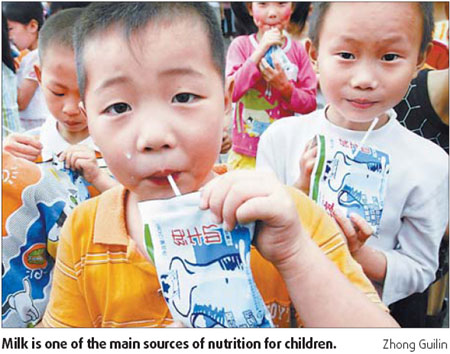China is not traditionally a nation of milk-drinkers - and with good reason. Around 90 percent of the Chinese adult population is thought to be lactose intolerant (ru tang mei que fa), which means they have low levels of the enzyme that normally digests lactose, the sugar found in milk and milk products.

In fact, worldwide, a huge percentage of people of Asian and African origin struggle with milk digestion and it is more common to be lactose intolerant, than not.
Fortunately, lactose intolerance is not an allergy and the immune system is not involved, meaning those affected can cope with varying small amounts - a drop of milk in tea is usually fine but a milkshake spells trouble.
Symptoms of lactose intolerance occur because undigested lactose passes through to your colon where bacteria feast on it resulting in the unsociable symptoms of gas, bloating, cramps and frequent trips to the toilet with diarrhea.
Typically, infants are able to digest milk which is, of course, their main source of nutrition. Those with genetically inherited adult lactose intolerance then gradually lose their milk digesting-capacity from around age 8 onwards.
People of European descent have a much greater ability to digest milk, likely an evolutionary response to the heavy dairy industry in these parts. However, around 20 percent of the adult European population may also be lactose intolerant and awareness of this has only recently been raised.
Problems can also occur for foraging foreigners in China struck down with gastroenteritis as the lactose-digesting enzymes in your small intestine can die temporarily. This should only last for a few weeks, but during this time milk is off the menu.
China has recently experienced huge growth in the dairy industry and milk, yoghurt and even cheese are now familiar on the shop shelf. So are all "dairy" products off-limits to the lactose intolerant? Certainly not.
Lactose tends to remain in the watery part of milk when curds (solids) and whey (liquids) are separated, which means that the higher the fat content, and more solid the dairy, the lower the lactose content. Butter and cream have very low levels of lactose, and providing you use these sparingly (your heart will thank you too) this shouldn't present a problem.
Cheese (nai lao) made using traditional methods has a very low lactose-content - especially hard cheese like cheddar. Chinese cheeses such as "ru bing", a firm goat's milk cheese from Yunnan province, and cheeses from Tibet, Inner Mongolia and Xinjiang autonomous regions are usually tolerated. Be wary of much of the sliced cheese available in Chinese supermarkets as this usually has milk products added back into it during processing.
Fermented dairy products, such as yoghurt (suan nai), which is now widely consumed here, are usually well-digested because the bacteria involved in the yoghurt-making process produce lactase which breaks down the lactose before it is consumed. Mongolian nomadic cuisine features several dairy foods fermented with kefir (bacterial culture), such as "Eezgii" which is roasted to a golden color, and has a slightly sweet and grainy texture and "Byaslag" - cheese which is eaten dried or fresh.
If you are lactose intolerant, it is essential to include other sources of calcium in your diet to keep bones healthy and blood pressure controlled. In addition to the low-lactose dairy products previously described, lactose-free calcium sources are aplenty in China.
Calcium-fortified soya milk (dou jiang) and tofu (doufu) are excellent; green vegetables such as spinach (bo cai), kale (gan lan) and broccoli (xi lan hua) make a good contribution; sesame seeds (zhi ma) and nuts, such as almonds (xing ren), also contain reasonable amounts.
Seafood - especially shell fish, prawns and tinned fish with soft bones - are also a good way to ensure your calcium intake.
This nutrition-related column is written by Nina Lenton, a qualified dietitian living and working in Beijing. Contact her at nina.lenton@ikang.com.
(China Daily May 14, 2008)